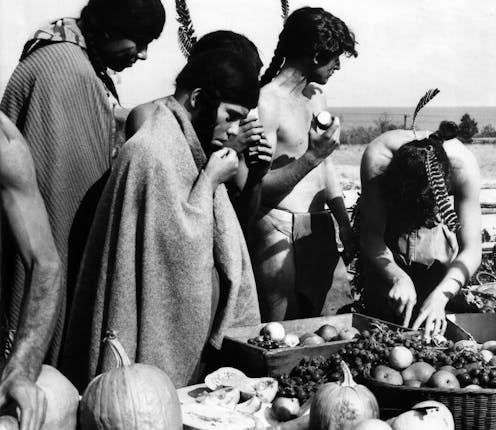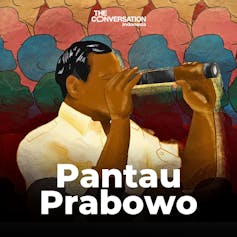Thanksgiving stories gloss over the history of US settlement on Native lands
- Written by Lisa Michelle King, Associate Professor of English, University of Tennessee

Too often, K-12 social studies classes in the U.S. teach a mostly glossed-over story of U.S. settlement[1]. Textbooks tell the stories of adventurous European explorers founding colonies in the “New World,” and stories of the “first Thanksgiving” frequently portray happy colonists and Native Americans feasting together. Accounts of the colonies’ battle for independence frame it as a righteous victory. Native American removal might be mentioned as a sad footnote, but the triumph of the pioneer spirit takes center stage.
As a scholar of Native American and Indigenous rhetorics[2], I argue that this superficial story hides the realities of what many historians and activists call “settler colonialism[3].” Historian Lorenzo Veracini[4] asserts that colonial activity isn’t just about a nation sending out explorers and bringing back resources, or what scholars refer to as “classical colonialism.” It’s also about what happens when a new people moves in and attempts to establish itself as the “superior” community whose culture, language and rights to resources and land supersede those of the Indigenous people who already live there.
When U.S. history, culture and politics are understood through the lens of settler colonialism, it’s easier to understand how, as historian Patrick Wolfe[5] wrote, “settler colonizers come to stay: invasion is a structure, not an event[6].”
US policies and why they matter
While settler colonial policies can include genocide, they take many forms.
Deceptive and broken treaties[7] forced Native American nations to give up vast portions of their homelands. For example, in eastern Tennessee, the Treaty of Holston, signed in 1791, was made in theory to help establish clear boundaries between Cherokee and settler communities.
The U.S. government would receive land, and the Cherokee would receive annual payments, goods and the promise of the government’s protection in return. Instead, settlers moved onto Cherokee land and the U.S. government did not intervene. By 1798, the First Treaty of Tellico forced the Cherokee to give up the land the settlers had illegally taken, plus some. Year by year, the Cherokee and other tribes were pushed out.
How the U.S. acquired Native land.Forced outright removal[8] beyond treaties further deprived Native American nations of their land and attempted to erase them. Instead of supporting any kind of coexistence, legislation such as the 1830 Indian Removal Act[9] called for the complete removal of all tribes east of the Mississippi River.
Though the Cherokee and others fought such legislation in the courtroom, the result was the displacement of 100,000 Native people[10] from the eastern U.S. between 1830-1850 and the deaths of thousands of Cherokee, Choctaw, Chickasaw, Muscogee and Seminole people on the Trail of Tears[11].
Blood quantum systems of identification[12] attempted to make Native American people “disappear” by assigning Native American identity through counting the fractional amount of “Indian blood” and encouraging intermarriage with non-Native people. Once a certain degree of intermarriage was reached, a person was no longer considered Native and was not eligible for tribal enrollment.
As scholar and citizen of the Chickasaw Nation Elizabeth Rule[13] notes, many Native nations today have adopted the use of blood quantum as a form of identification, which remains a controversial issue inside and outside Native communities. At the same time, she observes, it is the sovereign right of those nations to make these choices. However, the problem of erasure through this system remains, as blood quantum requirements can deny citizenship to clear lineal descendants and complicate discussions about Freedmen[14].
Alongside these policies, education was used as a tool[15] to eradicate Native American languages and cultures by removing Native children from their families and forbidding them to speak their languages or practice their cultures. As the founder of the first boarding school, Carlisle Indian Industrial School[16], Richard Henry Pratt is well known for arguing to “Kill the Indian, Save the Man.” Abuse of students was not uncommon. Many boarding school survivors experienced the trauma of losing connections to their families and cultures, a pain that is still felt today[17].
Twentieth-century U.S. policies of relocation and political termination[19] further attempted to absolve the federal government of its treaty responsibilities to Native nations. If the U.S. government could “terminate” tribal nations by disbanding them as nations, then all obligations to tribes would legally disappear and all remaining tribal land would revert to government ownership.
After the passing of House Concurrent Resolution 108 in 1953, more than 100 tribes and 13,000 Native people experienced termination[20], and more than 1 million acres of land were lost. Further federal policies such as the Indian Relocation Act of 1956 encouraged tribal members to permanently leave reservations and relocate to cities to find work and thus assimilate into U.S. society.
Overall, these policies were not fully carried out, and many tribal nations advocated for their status to be restored. Yet real damage was done to the tribal nations that endured termination, and relocated tribal members faced discrimination and disconnection.
Reducing harm
It isn’t possible to simply undo all of these policies and their impact. Yet scholars Eve Tuck and K. Wayne Yang[21] acknowledge that challenging those policies and reducing their influence, known as settler harm reduction, is a first step toward change. But for change to happen, those who benefit from the settler colonial system – whether original settlers or anyone today who gains advantage from these policies – need to work with Native American nations and communities toward finding active ways to do better.
The starting point is identifying the stories that still circulate in the U.S. about Native Americans and finding ways to change settler colonial assumptions[22] that still reinforce Native American erasure. With Thanksgiving right around the corner, I believe teaching the Thanksgiving story[23] alongside the Wampanoag peoples of today is an easy place to start. The past cannot be undone, but it doesn’t have to dictate the future.
References
- ^ teach a mostly glossed-over story of U.S. settlement (theconversation.com)
- ^ scholar of Native American and Indigenous rhetorics (english.utk.edu)
- ^ settler colonialism (www.tandfonline.com)
- ^ Lorenzo Veracini (www.swinburne.edu.au)
- ^ historian Patrick Wolfe (www.vu.edu.au)
- ^ settler colonizers come to stay: invasion is a structure, not an event (doi.org)
- ^ Deceptive and broken treaties (youtu.be)
- ^ Forced outright removal (www.loc.gov)
- ^ 1830 Indian Removal Act (history.state.gov)
- ^ displacement of 100,000 Native people (www.nps.gov)
- ^ Trail of Tears (theconversation.com)
- ^ Blood quantum systems of identification (www.npr.org)
- ^ Elizabeth Rule (www.elizabethrule.com)
- ^ Freedmen (www.hcn.org)
- ^ education was used as a tool (www.bia.gov)
- ^ Carlisle Indian Industrial School (carlisleindianschoolproject.com)
- ^ a pain that is still felt today (apnews.com)
- ^ AP Photo/Elaine Thompson (www.youtube.com)
- ^ relocation and political termination (www.apmreports.org)
- ^ experienced termination (americanarchive.org)
- ^ Eve Tuck and K. Wayne Yang (jps.library.utoronto.ca)
- ^ change settler colonial assumptions (rnt.firstnations.org)
- ^ Thanksgiving story (www.mayflower400uk.org)
Authors: Lisa Michelle King, Associate Professor of English, University of Tennessee




